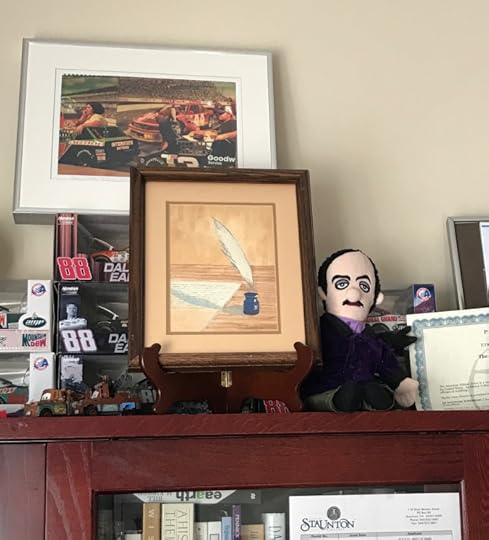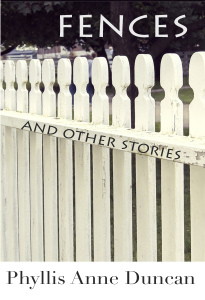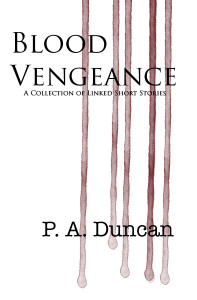Phyllis Anne Duncan (P. A. Duncan)'s Blog, page 22
January 18, 2017
52-3 My First Love and/or Kiss
When I was fourteen and never-been-kissed, my twelve-year-old cousin, who’d apparently hit that first-kiss milestone not long before, decided I needed my first kiss. She identified one of her…
Source: 52-3 My First Love and/or Kiss


January 14, 2017
52-2 My Earliest Writing Memory
This was really supposed to be “My Earliest Memory,” but that involved a bath in an old wash tub and poop. I thought I’d spare you and change it to my earliest writing memory. How…
Source: 52-2 My Earliest Writing Memory


January 3, 2017
52-Week Writing Challenge
Now that I’ve had a few days to come down from the holiday stress—and the conclusion of my haiku-a-day challenge—I felt it was time to move on to the next challenge. Rather than stress myself with …
Source: 52-Week Writing Challenge


December 31, 2016
Haiku 366-356 to -366b… What?
Oops! Somewhere along the line, I miscounted the number of haiku, and I’m ending the year with Haiku 366-366b. I’m certain the actual total is 366 because even leap year doesn’t a…
Source: Haiku 366-356 to -366b… What?


December 19, 2016
Haiku 336-338 to -355
Haiku 336-338 (12/1/16) countdown to Yule surrounded by joy bah humbug Haiku 366-339 (12/2/16) encompassed by writers tea and scones heaven Haiku 366-340 (12/3/16) a day free no adulting in sight m…
Source: Haiku 336-338 to -355


November 30, 2016
Haiku 366-306 through –337
November 17, 2016
NaNoWriMo 2016
I don’t know why the words came so freely this year, other than I had a solid idea in September and fleshed it out (notes, not an outline) in October. Some things that had happened in my past had long been waiting for a way to express themselves, and it turns out the idea for this year’s NaNoWriMo was the perfect medium.
Some Characters Return
In 2012 I wrote a piece of flash fiction, which was well-received on a site where I posted short fiction in response to a photo prompt. The flash fiction piece was about a young woman hiding the body of a baby in the wall of a half-finished house. Almost every commenter said, “You have to tell the story of how that happened.”
In November 2012, I did, and the result was Supreme Madness of the Carnival Season, a literary novel about a successful author (so, not autobiographical) and her husband who find a baby’s bones in the wall of a room they’re renovating. The author, who’d suffered a stillbirth some years before, wants closure for the abandoned baby and sets out to find who put the baby in the wall.
The novel’s working title was “Amontillado,” from Edgar Allan Poe’s story, “The Cask of Amontillado,” which involved burying someone alive in a wall. As the story moves back and forth in time between roughly present day and 1944, the author has to face reality about her life and her marriage, but the twist comes when she discovers whose baby ended up in her wall.
I intended for it to be a standalone, but as someone who beta-read the MS pointed out, I left something hanging.
For NaNoWriMo 2016, I brought some of the characters from 2012 back, put them solidly in 2016–more or less–and had a new secret dumped in the lap of the author, another mystery for her to become involved in.
This one is more of a “real” mystery–I think–though like Supreme Madness the death in question occurs some years before, it’s pretty obvious who did it, but there’s a twist at the end.
This year’s working title is, Mournful Influence of the Unperceived Shadow, taken from a line in another Poe story, “The Tell-Tale Heart.”
Yeah, I have a Poe thing. In fact, he watches over me as I write.

Edgar Allan Poe, watching from his perch atop my bookcase.
October 29, 2016
Haiku 366-287 to -305
Haiku 366-287 (10/11/16) words on a page my life’s work something to say Haiku 366-288 (10/12/16) celebrate the voyage indigenous genocide only in America Haiku 366-289 (10/13/16) truth hides behin…
Source: Haiku 366-287 to -305


October 17, 2016
Ring Out the Old, Ring In the New!
Wait, we’ve got a few months to the new year, don’t we?
Of course we do. I’m announcing a new cover for an old book. Well, it’s not that old. It came out in 2012.
I’m working on a little project to update the covers of my short story collections to make them stand out more. It’s been fun and has stretched my PhotoShop skills, but I like the results.
So, have a look.
Fences and Other Stories
This was a collection of some literary and fantasy stories, ones I’ve always been fond of. Here’s the cover I selected from CreateSpace when I published the collection in 2012.

2012 Cover
Not bad, but I could do better–or so several people told me. Four years later, I know about a great site called Pixabay, which is a large repository of public-domain photographs. You can use the photos commercially and without attribution–though I’ve at least given Pixabay an attribution. Pixabay’s selection is extensive, though the more obscure or detailed you get in your search, the fewer returns you get.
The title story for this collection (“Fences”) involves a white, picket fence, which this cover doesn’t evoke at all.
A search on Pixabay, and I got more than enough to choose from.
I selected this one, imported it into PhotoShop, added the title, subtitle, and byline (of

2016 Cover
course), and this result, I think, is more true to the title story.
This is one of the advantages of indie publishing: If you want to refresh a cover or even the interior (I, uh, may have found a few typos.), it’s relatively easy to do. Your book isn’t available for sale for a couple of days until the databases communicate, but for me, it was worth it for a better-looking cover.
What say you?
Blood Vengeance

2012 Cover
I used to be into minimalist covers. I wanted people to be attracted to the story inside, not pretty cover art. Yes, I was naive. When Blood Vengeance, my first collection of espionage stories came out in 2012, I thought this cover, again from CreateSpace, was eye-catching. I liked the cover color and the stark font for the title.
It resonated with me, and with some readers, because when I sold it side-by-side with another book, which had art on the cover, the minimalist Blood Vengeance cover out-sold the other.
After a few years of reflection, and learning about the importance of a good cover for an indie-published book, I came to realize the cover was dull as rust.
Another excellent resource for indie authors is SelfPubBookCovers. For relatively low prices (most well under $100), you can purchase a professionally designed cover, which you can customize yourself, either on the site or in PhotoShop, which is what I did. (It can also be imported into other graphics programs and sites, e.g., Canva.) For the price, you get a 300 dpi jpeg suitable for a print cover and a 72 dpi jpeg for a Kindle or ebook cover. All you have to do is give an attribution to the cover’s artist, which SelfPubBookCovers provides.
You can also pay extra for more customization, including a back cover and a spine, and for additional covers for a related series of books. I purchased a cover from SelfPubBookCovers for my 2015 novella, The Yellow Scarf, and I was wowed by the result.

2016 Cover
Here’s the new cover for Blood Vengeance. Again, I feel as though this cover, even in its simplicity, is more eye-catching and relates better to the title story (“Blood Vengeance”).
The other thing you may have noticed is a slight change in the byline. The espionage genre is mostly a man’s game. That’s changing. I’m certainly not hiding the fact I’m a woman who writes about spies, but bearing in mind the person who picks up a book on the basis of its cover, why not give myself a little extra step on that break-in ladder? Again, I don’t hide my gender–you’ll find it on the “About the Author” page in the book.
What’s Next?
Expect new covers for 2012’s Spy Flash and 2015’s The Better Spy, as well as a new cover for the other 2015 novella, My Noble Enemy.
And before the year is out–[insert drum roll here]–cover reveals for Spy Flash II and my first novel, A War of Deception.
Yes, you read it here first. In 2017 my very first, standalone novel will come out.
Are you as excited as I am?
P.S., I doubt it.
October 13, 2016
Why Do I Write?
I’ve reposted the meme about (paraphrased) “writing is like breathing; if I don’t do it I die” several times. A bit dramatic, of course, but I’ve spent so much of my life writing, I can’t imagine doing anything else. When I got a job as a reporter on an aviation magazine, it was a died-and-gone-to-heaven moment: They paid me to write about what I loved, airplanes.
I write because it’s how I communicate best. Often, the spoken word fails me, but the written word never has.
I write because I feel deeply about the world around me. When I saw genocide in the Balkans, I had to write about it. When I saw a disproportionate number of black men killed by police, I had to write about it. When I see injustice, racism, sexism, etc., I have to write about it.
Writing for me is catharsis. I’ve exorcised the demons of my father’s suicide and my mother’s alcoholism by writing them into my fiction. As I said, when the spoken word fails me…
How I Got Started
I started writing stories in elementary school with my weekly list of spelling words. You remember–the exercise where you had to use each correctly in a sentence. My sentences comprised a story, usually about horses.
One year for Christmas, I got an alphabet, rubber-stamp set, and I set about printing a newspaper for my neighborhood–based on what I heard my mother and her friends talking about at the kitchen table. I hand-printed, letter-by-letter, a half dozen copies and left them on doorsteps. Needless to say that didn’t go over well with my mother because I’d essentially repeated her gossip. The rubber stamp set mysteriously disappeared.
In high school, my English teacher caught me writing fan fiction in her class. She confiscated my notebook but gave it back to me the next day. “Keep writing,” she said, “just not in my class unless it’s an assignment.” My very first spy story she accepted as an assignment for class. My first book of short stories, Rarely Well-Behaved, I dedicated to her.
In college, I was the first non-English major to be published in the literary magazine–my first published sci-fi story. (It sucked, as I discovered when I found it thirty-plus years later.)
I had a break in writing after college when I taught school for a few years. I got a job as an editorial assistant for an aviation insurance consortium, and that led to my dream job writing about airplanes and aviation for the FAA. While I wrote articles and briefing papers and white papers and studies and regulations and manuals and congressional Q&A, I still wrote fiction at home.
But it was a long, long drought of having my fiction published–more than thirty years. So, I decided it was time to retire and write for myself.
The Big Mo Builds
That first year after retirement, nothing got published. I remembered how much I disliked those rejection notifications, but I kept at it. First came a story in a start-up lit mag; then, another. Publication in an anthology. Placing well in a contest. Another anthology. More lit mags. Another contest.
In between were agent rejections, self-publishing some short story collections, small publisher rejections, and a few more agent rejections.
Still, all this has made me feel I’m on the edge of something I’ve wanted my whole life, something that’s about to happen. I’ve always said if I could simply get my stories in people’s hands they would find something to like about them, that they would want more.
In the midst of all this, I stopped being the writer others said I should be and became the writer I’m supposed to be.
Why do I Write?
Because it lets me be vulnerable and forces me to be authentic.
What more can you ask of life?







